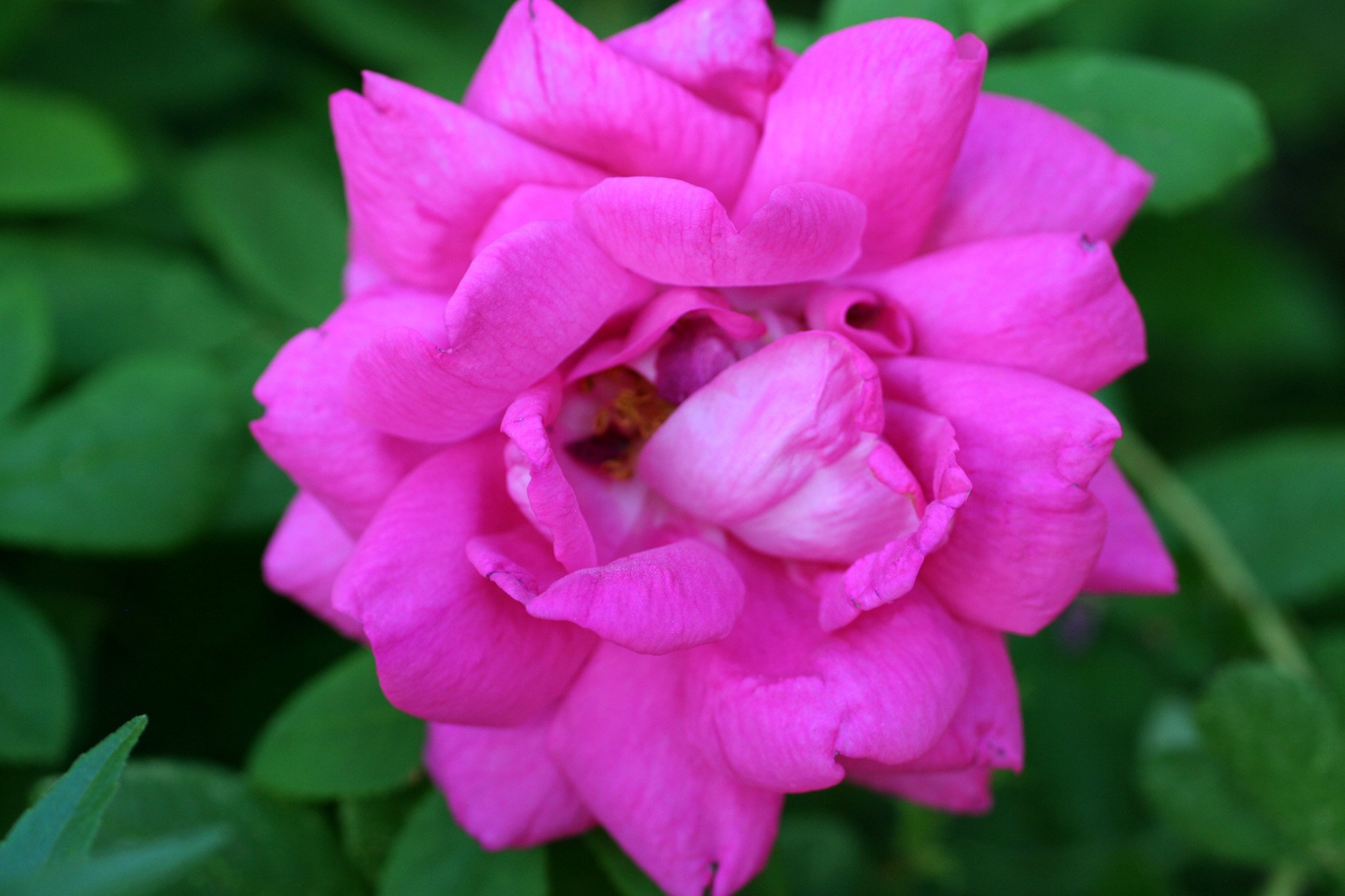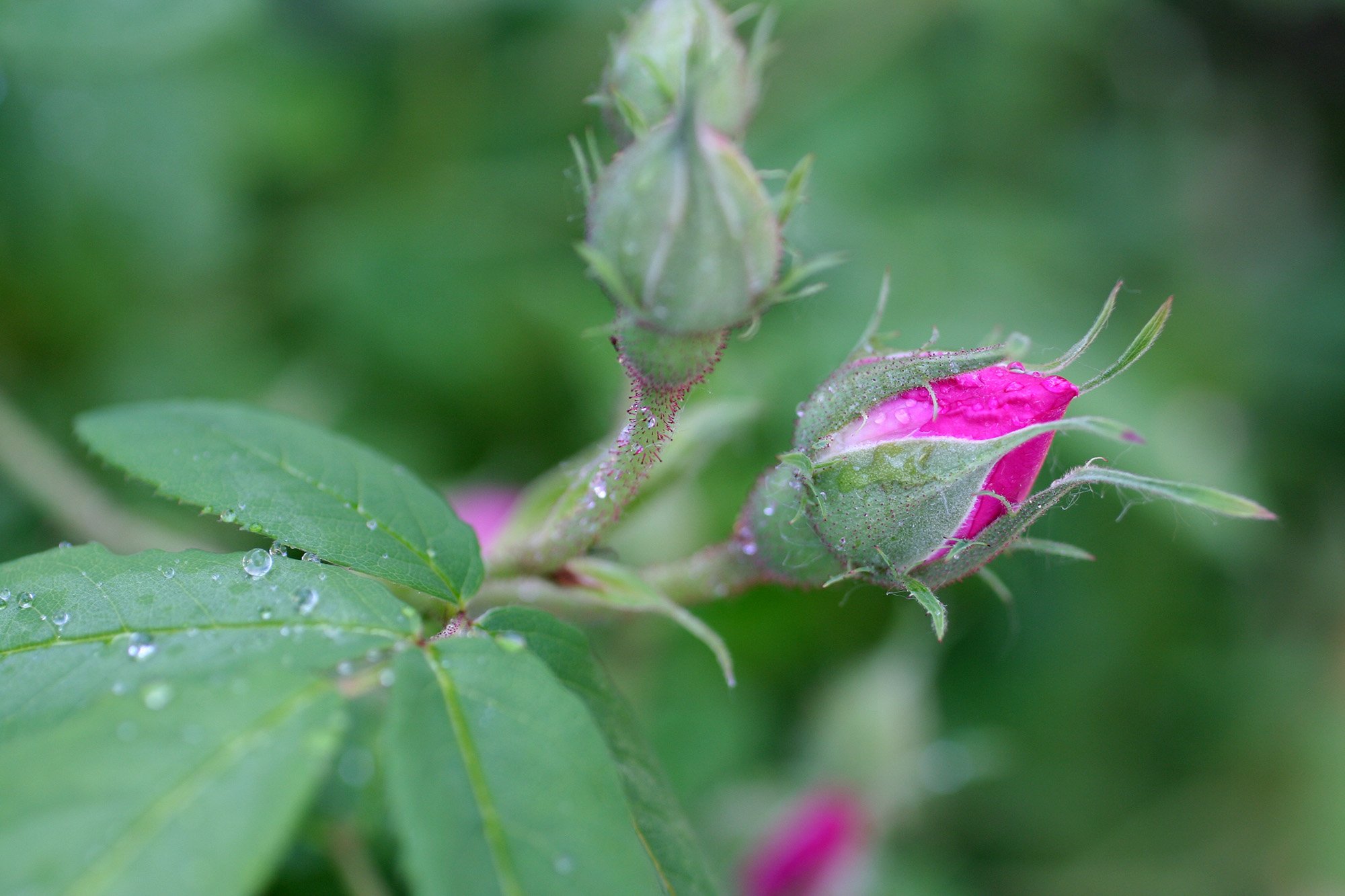Rose (Rosa spp.)
Author: Elaine Sheff
Family: Rosaceae
Appearance
Roses are perennial, woody, flowering shrubs. Rose is an ancient plant, with some fossils in America over 30 million years old7 There are over 300 species of roses, and over 18,000 cultivars.7 Most rose species are native to Asia, but there are native roses in Africa, Europe and North America as well.1 The flowers of most wild rose species have five petals, with the exception of Rosa sericea, which usually has four. Each rose petal is divided into two distinct lobes. The fruit of the rose is the small seeds, and they are surrounded by a berry-like structure, the hypanthium, called a rose hip, or “rosehaw”. Most roses have sharp growths along the stem. Commonly called "thorns", they are technically called prickles. Rose leaves are pinnately compound and usually serrated. 1, 14
Habitat
Wild Roses prefer to be in sun with well-drained soil. The average rose has a lifespan of 10-50 years or more.7 I have a heritage rose in my garden, with immense roots, that I believe to have been planted shortly after the house was built over 100 years ago.
Propagation
Collect rose hips once they are ripe (usually red or orange in color). Remove the seeds and gently rub the largest with sandpaper. Plant immediately and watch for seedlings the following spring.
You can also start new plants by digging new shoots that spread from the mother plant, or from cuttings. In the spring, my grandmother used to put glass jars over herb rose cuttings for 4-6 weeks, like a tiny greenhouse, to add extra protection.
According to William Cullina in his book Native Trees, Shrubs and Vines, “powdery mildew is usually not a severe problem in the garden and in the wild, but it can get pretty bad under irrigation in the nursery.” He therefore recommends keeping them in an open spot that gets sun and good air circulation, and watering in the mornings.
Roses don’t usually require much assistance once established. Generally wild roses prefer full sun and well-drained soil although some do fine in partial shade. In the spring, cut back deadwood but leave living, green canes.2
Companion Plants:
Lavender (Lavandula), Catmint (Nepeta), Verbena (Verbena), Garlic, Chives, Oregano (Origanum), Yarrow (Achillea), Anise-hyssop (Agastache), Culinary sage (Salvia officinalis), Rue (Ruta gravolens), Feverfew (Tanacetum parthenium), Parsley (Petroselinum), Thyme (Thymus vulgaris)3
Harvesting
I have used many roses as medicine. Often, I will sample a hip or petal to assess whether I’d like to collect it. I generally prefer wild or heirloom species for medicinal purposes. The flowers when in bloom, cane be used fresh or dried. Rose hips are best harvested when deep red in late summer and through the winter. They will be sweeter, but lower in Vitamin C after the first frost. Studies have shown that the higher the elevation you harvest hips, the higher the Vitamin C content they contain.16 Looking at past research, it seems fine to wildcraft wild rose. Guidelines recommend 20% of the fruits should be left on each bush to feed wildlife and encourage regeneration. Additionally, 20% of the stand should be left unharvested. Make sure to collect only hips or flower petals, leaving twigs and branches undamaged. 16
Dosage:
Tea: 3 cups a day
Tincture dose is 3–10 ml daily.6
Hips: 100 g fresh, or 45 g dry for antioxidant effects 16
Constituents:
Sorbitol, rubixanthin, tannins, organic acids, carotenoids such as lycopene, lutein, beta–carotene and zeaxanthin, cyanin, resin, volatile oils and waxes, terpenes, phenolics, glycosides, anthocyanins, and carboxylic acid. The hips also contain nutrients such as amino acids, flavonoids (quercetin, rutin, hesperidin, kaempferol), pectins, sugars, tannins, beta-sitosterol, long-chain polyunsaturated fatty acids, and galactolipids (namely GOPO), as well as vitamins A, B3 (niacin), C (ascorbic acid), D, E (tocopherol), folate, and minerals including magnesium and copper.5, 6, 7, 16
Actions:
Sweet, astringent, antidepressant, anti-spasmodic, aphrodisiac, sedative, digestive stimulant, expectorant, antibacterial, antiseptic, kidney tonic, menstrual regulator, anti-obesogenic (countering the onset of obesity), anti-inflammatory, antioxidant, antitussive, and antidiabetic. 6, 7, 16
Energetics
Rose is generally thought of in energetic terms as either neutral or slightly cooling.
When talking about rose family plants, herbalists sometimes use this acronym: “ARFA” Another Rose Family Astringent.
Medicinal Properties
Hips:
Vitamin C: The fruits of many species have significant levels of vitamins and have been used as a food supplement. 1 The rose hip, usually from R. canina, is used as a source of Vitamin C.16 Vitamin C content of rosehips generally ranges from 0.3-. 0.15% ascorbic acid. In Romania, researchers have found that higher altitudes correlate with higher ascorbic acid contents in Rosa canina. 16 Due to its fragility, Vitamin C in rose hips can be diminished or destroyed during drying, processing, storage and preparation (especially when using heat).11, 13, 16 The good news is that both the stability and bioavailability of vitamin C in rose hips is enhanced by the presence of flavonoids and organic acids, which inhibit oxidation and degradation.16 Rose hips are best used fresh or freshly dried and stored in cool temperatures (freezing is OK) with little to no light. Using rosehips within 3-6 months seems to be best.10, 12 Alternately, if you’d like to store them longer, an alcohol tincture will help to preserve many constituents. 15
Rose hip preparations are used for colds, fever, gout, polydipsia (abnormal thirst), and as an alterative to help manage wastes in the body.”16
For the digestive system and urinary tract, rose hips are helpful for gastritis, constipation, and diarrhea. They are supportive of the kidneys and lower urinary tract, acting as a diuretic as well as easing edema.
Rosehips are a good source of antioxidants helping protect against cell damage caused by free radicals. This makes them useful for improving skin elasticity and hydration.16 The anti-inflammatory effects of rose hips have been studied extensively for easing pain from rheumatoid and osteoarthritis as well as chronic musculoskeletal pain and sciatica. 16
Rose hips are excellent for the heart and cardiovascular system. They have been found to significantly reduce harmful blood fats including total and LDL cholesterol levels, as well as lowering high blood pressure. 16
A Randomized double blind placebo control (RDBPC) study published in 2015 looking at Diabetes, Metabolic Syndrome and Obesity found that rose hip seeds (100 mg rose hip with seed aqueous ethanol extract) reduced abdominal visceral fat significantly. 16
Seed:
The pressed seed oil of rose hips is used in many skin care recipes. Considered a “dry” oil, rose hip seed oil is a wonderful hydrator and penetrates dry skin easily, without leaning a greasy residue. The oil contains essential fatty acids making it a wonderful emollient for dry or mature skin.
It can be used straight from the bottle as a moisturizer, or can be incorporated into a cream, lotion, facial oil, or massage oil. Because it is so gentle, rosehip seed oil may be used undiluted on the skin. Due to its delicate constituents, refrigeration is recommended.4
Flowers:
Rose petals are gentle and slightly cooling. They are useful for treating diarrhea, constipation, and GI tract inflammations and irritations.
The 17th century English herbalist, botanist, physician, and astrologer Nicholas Culpeper (1616-1654) stated that ripe hips made into a conserve (a preparation typically made with sugar or honey) would “gently bind the belly, and stay defluctions [the flow of humors, or body fluids] from the head upon the stomach, drying up the moisture thereof, and promoting digestion.”16
For the nervous system, rose petals will gently soothe headaches, relieve pain and act as a mild antidepressant.
They are toning to the reproductive system and useful for menstrual irregularities and excessive menstruation. Rose is considered aphrodisiac, increasing sexual desire, arousal, and our receptiveness to pleasure.
Rose is cardiotonic, helping to strengthen both the physical and emotional heart. Rose can help ease sorrow, grief and heartache.
Rose petals are excellent for skin health. They can be used for healing wounds, and are antioxidant, good for the complexion, and anti-inflammatory.8
To treat the mucus membranes, rose can be used as a mouth wash, gargle for sore throat, douche or vaginal steam.
eye drops: conjunctivitis, conjunctival xerosis (dry eye) (hydrosol too)
Medicine Making:
Honey: Rose makes a decadent honey that is excellent for extracting essential oils. I like to strain the honey and then refrigerate the petals or hips using them to spread on toast, similar to preserves.
Infused oil: The petals and hips make luxurious and aromatic oils for the skin. astringent, skin-conditioning, and tonic functions.16
Tea: A hot tea of rose hips will lower Vitamin C content, so I feel it is better to use water that is warm but not too hot or make a cold infusion. Rose petals make a lovely and aromatic tea.
Glycerite: Good for extracting tannins, but not Vit C15
Alcohol Tincture: Good extractor and preserver of Vit C15
Recipe Links: Rose Cordial, Rose cookies
Other Uses
Rose has been a symbol of love, purity, faith, and beauty since the ancient times. In ancient Greece, the rose was closely associated with the goddess Aphrodite.
Roses have been valued as a food and medicine for centuries, in many cultures around the world. 2
Rose is used in making jams, jellies, marmalade, teas, soups, vinegars, syrups, beverages, puddings, pies, bread, wine, creams, and ice creams. Rose petals are candied or sprinkled onto salads and desserts. Rose hip pectin has been used as a thickener. 1, 2, 3, 7
Rose pollen is a valued food source for many beneficial insects, including bees. Rose hips are a winter food for birds and mammals such as waxwings, pine grosbeaks, grouse, rabbits, coyotes, and skunks.2
Complimentary botanicals:
Hawthorn (Crataegus spp.), Motherwort (Leonurus cardiaca), Raspberry (Rubus spp.), Linden Flower (Tilia spp.), Hibiscus (Hibiscus sabdariffa)
Contraindications
None known. Rose is very safe. It is safe for use with pregnant women and babies. The hairs surrounding the seed can be irritating to mucus membranes. 6
ELAINE SHEFF
CO-DIRECTOR, CLINICAL HERBALIST, RH (AHG)
The author of several books on herbal medicine and healing, clinical herbalist Elaine Sheff has been passionate about sharing herbal knowledge for over 30 years. Her latest book is Naked: Botanical Recipes for Vibrant Skin and Healthy Hair.
Elaine is the Co-Director of Green Path Herb School, located in Missoula, Montana, where she strives to inspire and empower students and clients to remember their connection to the earth, the plants, and their own healing process. She is a professional member of the American Herbalist Guild and teaches workshops, and at conferences, both nationally and internationally. As a certified Instructor of the Natural Family Planning and Fertility Awareness Methods, Elaine has helped many couples to avoid or achieve pregnancy naturally. She has written numerous articles about her family’s journey with epilepsy and a special needs child. Elaine has written for publications including the Journal of Medicinal Plants and their Applications, Mamalode, and Aromaculture magazine.
You can often find her bent over an herb in her garden or marveling at small flowers in mountain meadows with her husband, sons and dogs. Elaine’s workshops have been featured at conferences including the Traditions in Western Herbalism Conference, Montana Herb Gathering, Northwest Herb Symposium, Midwest Women’s Herbal Conference, Spokane Herbal Faire, Pacific Women’s Herb Conference, Inland Northwest Permaculture Convergence, the Ecoexpo, the Mountain West Herb Gathering, and the American Herbalists Guild Symposium.
References:
En.wikipedia.org. 2022. Rose - Wikipedia. [online] Available at: <https://en.wikipedia.org/wiki/Rose> [Accessed 2 August 2022].
Canadian Wildlife Federation, Wild Roses, https://cwf-fcf.org/en/resources/encyclopedias/flora/wild-roses.html.
Canadian Wildlife Federation, Wild Roses, https://cwf-fcf.org/en/resources/encyclopedias/flora/wild-roses.html.
“Rosehip Seed Oil.” Mountain Rose Herbs, https://mountainroseherbs.com/rosehip-seed-oil.
Herbal Constituents, Foundations of Phytochemistry by Lisa Ganora
https://citeseerx.ist.psu.edu/viewdoc/download?doi=10.1.1.616.7744&rep=rep1&type=pdf
https://www.webmd.com/vitamins/ai/ingredientmono-839/rose-hip
Elpel, Thomas J. Botany in a Day: The Patterns Method of Plant Identification: Thomas J. Elpel's Herbal Field Guide to Plant Families. Pony, MT: HOPS, 2004. Print.





